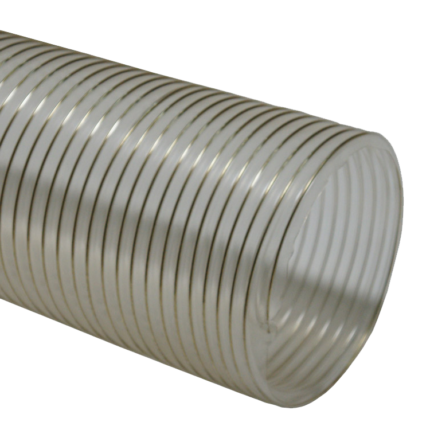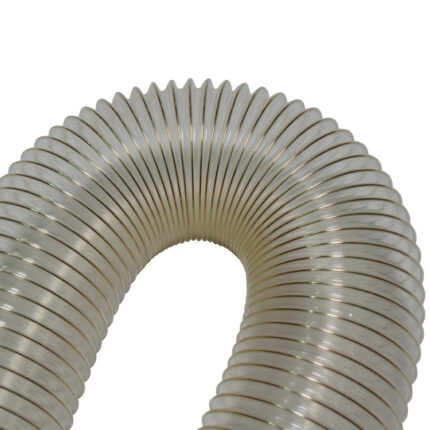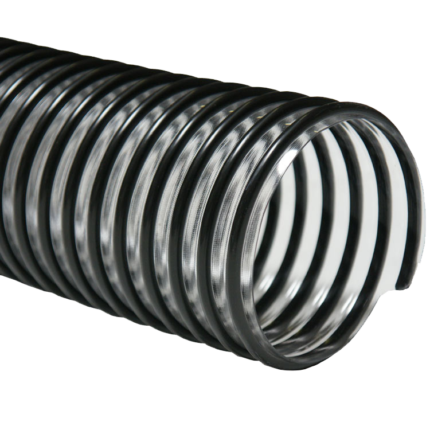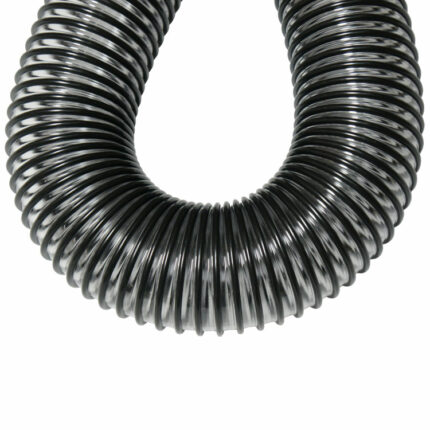A portable air-conditioner is a transportable, air-cooling device that can provide supplemental support for small areas of your home. When conjuring up images of a typical, portable air-conditioner, do you picture a machine with one hose or two hoses? Funnily enough, whichever depiction comes to mind would be correct! There are many different types of portable air-conditioners—from the single-hose, the dual-hose, and the ventless, evaporative cooler. A portable air-conditioner can technically have anywhere from zero to two portable-air-conditioner hoses—and this does not even include the drain hose or additional ductwork! Portable ACs and their hoses go hand-in-hand, with a portable-AC exhaust hose’s job being to ventilate heat and moisture away from the unit. Each of these units have their own specific pros and cons, with small details varying from model to model. This means that what might be the best portable-AC for you may not be the best for somebody else. It all depends on the purpose and intentions you have for your portable AC. You may want your unit to feature 2 portable-air-conditioner hoses while another person might want just one. As long as you educate yourself on portable-air-conditioning and hosework, you can accurately align your purchase with your expectations. You will not set yourself up for disappoint if you know exactly what to expect. You may be asking questions such as:
• Where do you vent a portable air-conditioner?
• Why does my portable AC have two hoses?
• Is there a portable air-conditioner without a hose?
• Are dual hose portable-AC units better than single hose or ventless?
“Air Ventilator Orange”
“PVC Flexduct General Purpose Clear”
“Tornado Flex Insulated AD”
Where Do You Vent a Portable Air-Conditioner?
You should vent a portable air-conditioner into an open space outside of the room you are cooling. This includes the outdoors, as well as other, unused spaces of your home such as your garage. Just keep in mind that wherever you ventilate your unit, heat and moisture will build in that area if it does not have proper air circulation. Whether you have a single-hosed unit or a 2-hose portable-air-conditioner, ventilation pertains to the same guidelines. A common method of venting your portable-air-conditioner exhaust-hose is out of windows. Many units will, in fact, include a window venting kit so that you can begin using your portable AC immediately! These window kits are panels that allow your portable-air-conditioner duct to access the outside while sealing off the rest of the window opening so that no air can enter your room. This ensures that the exhaust is blowing out, but nothing is blowing back in. You can also vent a portable AC out of sliding doors as well. There is a similar, sliding-door kit available for this scenario as well. Ducting through walls is also a plausible option for ventilation. This can be achieved by attaching your hose to existing wall vents or creating openings in your wall yourself. Whether or not you can vent out of doors, windows, or walls—however—does depend on the length of your portable-air-conditioner tube. Window access may be limited with the portable-AC-unit hose that comes with your model, as these pipes tend to be around 5 to 7 feet in length. Having only 5 to 7 feet in length to work with may not bode well for people with intricate room-layouts. If you are thinking, “I do not want my air-conditioner hose near me or my bed,” but have no option due to the length of your pre-existing hose, you can always opt for a portable-AC replacement-hose. Realistically, a portable-air-conditioner tube-extension can be applied to any length of hosework with the addition of hose attachments. Ducting.com sells metal clamps and connectors in order to extend your hosework. Connectors are perfect for creating long runs of ductwork at a low-price point. However, purchasing an extra-long, portable-AC exhaust-hose to replace your existing hosework means that all of your hosework will be the same quality, exhibiting strong, physical features. A long, exhaust-hose made from excellent materials is—for many reasons—more appealing than chains of ductwork, benefiting you in the long run. At Ducting.com, our hosework comes in a variety of lengths that can provide more than enough ducting for your situation. Our selection of portable-air-conditioner hoses can come in standards lengths of 12.5, 25, or 50 feet, depending upon the model. All of our pipes, however, can also be customized into any-sized length under 50 feet! With an ample amount of hosing to work with, properly venting your portable air-conditioner will be an easy task. Even if you choose to utilize hose attachments, Ducting.com sells quality-metal connectors and clamps at an affordable price in order to help you do so. Either method you employ will be sufficient at venting your portable-AC, as long as you make sure to extend these hoses to your nearest window, door, or wall vent.
Why Does My Portable AC Have Two Hoses?
A portable AC will have two hoses in order to neutralize negative pressure that builds inside of the room it is cooling. The secondary hose draws air from the outside, while the first hose expels heat and moisture from the portable air-conditioner. The second hose is used to replace the air that is exhausted outside with new air. For any portable-AC unit with hose-work, ventilating the device will remain the same whether or not it is a dual-vent portable-AC. Heat and moisture are pulled from the air as a result of the cooling process and ushered out through the flexible-exhaust-hose for portable-air-conditioner
units. Again, this is the task of the primary hose for any portable-air-conditioner with tube-work. The single-hosed portable-AC, however, does experience drawbacks in the fact that utilizing a singular hose will generate negative air-pressure inside of the room you are cooling. But what is negative air-pressure? Negative air-pressure is when the pressure of air inside a certain space is lower than the pressure of the air outside it. This means that there is less air inside than outside. This occurs when you run appliances that remove air from the interior of your home without returning it. Because there is less air inside the room than outside of it, air pressure will attempt to replace the lost air by pulling it from other places. Warm air will seep in through cracks in your door and window, among other places. With an influx of heat, your portable AC will work harder to combat the temperature, furthering the cycle of negative air-pressure. However, this is of no consequence for the 2-hose air-conditioner. Dual-vent portable-AC units have two hoses: one to function as an exhaust tube, and the other to work as an intake. The second hose combats negative air-pressure by drawing in air from the outside to supplement the air that is lost when exhausting. This second hose replenishes the air inside while also cooling the inner machinery of the unit, making it work more efficiently. By replacing the air that is vented outside, the 2-tube portable-air-conditioner will not be subjected to negative air-pressure, allowing it to work productively. The air that is being drawn from the outside also cools down the condenser coils inside the unit, ensuring further efficiency.
With air pressure constricting your portable-AC and its exhaust hosework, you might be worried about the pressure of the air inside of portable-air-conditioner hoses. A portable-air-conditioner vent experiences less air-pressure inside of the hose then, say, a retractable vacuum-hose for a pool cleaner. Despite the low amount of internal air-pressure as opposed to vacuum-related hosework, portable-air-conditioner duct-work should still be composed of durable materials in order to protect the interior as well as the exterior. Flexibility is also an important factor to consider for portable-air-conditioner hoses, as this attribute allows the hose to be crushed and bent while still maintaining its structure. An air-conditioner vent/hose should be bendable in order to accommodate the layout of your home. Flexible, portable-air-conditioner tubing will allow you to manipulate your hosework into twists and turns that can avoid obstacles in your home while also maintaining proper ventilation. It will also enable you to hide your portable AC with hose-work if you do not wish for visitors and guests to view your device and its attachments. Simply lead your exhaust hose behind couches, bed-frames, or other furniture in order to keep your ductwork out of sight! At Ducting.com, our Air Ventilators are among one of the more flexible options of portable-AC hose-work. For example, the Air Ventilator Black features a compression ratio of 9 to 1, meaning that a 9-foot section of this hose can be pressed down to just 1 foot! The Air Ventilator Black is a lightweight hose composed of PVC-coated fabric, reinforced with a steel-wire helix. The fabric composition allows this hose to be easily manipulated, while the PVC-coating ensures that it will be protected from moisture, chemicals, and outside abrasions—just to name a few. PVC is a great thermoplastic that is used in a variety of applications for its resilience. This plastic can withstand moisture, fumes, flex-fatigue, and physical-force, making it an excellent material for portable-air-conditioner hoses. The light weight and the compressibility of the Air Ventilator Black also makes for convenient transportation. Instead of having to lug around a, say, 25-foot-section of heavy hosework, the Air Ventilator can be compressed from 25 feet to just over 2 and can weigh just as little as 5 pounds—depending on the inside diameter and length. Whether your portable AC has one hose or two, quality ductwork is the secret to an efficient unit. Flexible, durable hosing can ensure that your device is working at its maximum potential so that your portable air-conditioner can properly-functioning exhaust and intake hoses.
Is There a Portable Air-Conditioner Without a Hose?
The evaporative cooler, otherwise known as the swamp cooler, is a portable air-conditioner without an exhaust hose. Even though these coolers do not require traditional exhausting via hose, swamp coolers still need ductwork in order to conduct cold air to whichever room you intend. Evaporative coolers do not require a portable-AC exhaust-hose because they remove heat through the process of evaporation. The cooling process begins when hot air that is sucked into the unit interacts with water-soaked condensation-pads. When the hot air and water interact, the liquid turns into a gas, and heat is removed.
Water is now turned into water vapor and blown out with the cold air. The natural byproducts of portable-AC exhaust are incorporated into swamp-cooler ducting, allowing these units independence from exhaust hosework. Despite this freedom from exhaust ducts, evaporative coolers are not completely exempt from hosework or ventilation in general. Evaporative coolers still require new, dry air to replenish the cold, humid air that it is pumping out. This process is similar to the negative air-pressure generated by single-hosed, portable ACs, because there is less, dry air than there is moist air. Like individuals in a crowd, air wants to go wherever there is the least resistance—meaning that dry, hot air will want to go inside, where there is less air of its own kind. This is why evaporative coolers require venting in the form of window or doors openings. Achieving ventilation for a swamp cooler is easily done, but what about swamp-cooler ductwork? Evaporative-cooler hose-work funnels the cold air produced by a unit to wherever you want it to go. Whether it is inside of your home or to your bedroom, you can choose to install swamp-cooler ductwork in practically any room you want! There are different names of ducting for the different types of evaporative coolers, though they are all essentially the same hose. Up-ducts for evaporative-cooler-units situated on the ground floor outside your home are common models. A swamp-cooler downdraft duct will be used by a rooftop swamp-cooler and a swamp-cooler side-draft duct can be used for coolers mounted on a window. AC tube-work for evaporative cooling—despite their names—are all the same, and can actually benefit from insulation. An insulated, portable-AC hose’s job is to prevent the air inside of the hose from losing its heat. Conversely, an insulated, portable-air-conditioner hose can also help maintain the temperature of cold air inside the ductwork. This is helpful for ducting the cold air from your swamp cooler to the inside of your home. For example, Ducting.com’s HVAC Insulated-Flex Ducting is a portable-air-conditioner insulated-exhaust-hose that features insulative layers of PET-film, aluminum foil, and fiberglass. The aluminum layers located on the interior and exterior of this hose allow temperatures inside the hose to remain consistent while reflecting temperatures outside of the hose. The aluminum-foil exterior is the perfect feature for outdoor ductwork—like in the case of swamp-cooler up-ducts or a swamp-cooler downdraft vent that is exposed to the outside. For these externally-located applications, the aluminum-foil exterior of the HVAC Insulated-Flex will reflect the radiation and heat from the sun’s UV rays, leaving the interior unaffected. UV radiation will eventually break down other types of hoses, but not the HVAC Insulated-Flex! Whether you are using this hose to connect to an evaporative-cooler ceiling vent that leads to the interior of your house, or if your ductwork is located solely inside, an evaporative cooler can still benefit from an insulated air-conditioning hose. Portable-air-conditioner hoses such as the HVAC Insulated-Flex will help preserve the temperature of the air you are ducting, allowing fresh, cool air into your home. Insulated ductwork is an important part of the otherwise exhaust-less evaporative-cooler.
Review: Are Dual-Hose Portable-AC Units Better Than Single-Hose or Ventless?
Dual-hose portable-ACs are better than single-hose or ventless units for people that are looking for a device that can efficiently cool large areas. However, single-hosed and ventless portable-AC units have their own set of pros and cons that could distinguish them as “better,” depending upon the people that use them. A single-hose portable-AC is typically more cost-effective than a 2-hose AC-unit. Single-hosed units are priced lower and consume less energy, cutting down on your electricity bills. This makes the single-hosed portable-AC ideal for a person trying to cool a smaller room while working on a budget.
A two-duct portable-AC is more efficient and can be used to cool larger spaces than a single-hose AC. However, the two-tube portable-air-conditioner will be noisier—as it contains two internal exhaust fans—and will use more energy due to this additional machinery. Evaporative coolers, on the other hand, will be the most environmentally-friendly option. Swamp coolers do not require much electricity because they do not contain condenser coils or compressors. These units can also utilize evaporative-air-cooler ducting in order to replace centralized AC, reducing your overall energy-bill and bringing clean, fresh air into your home. Unfortunately, swamp coolers can only be employed in dry climates where humidity does not exceed 60%. Because evaporative-air-cooler vents pump out cool, moist air, that means if the humidity is already high, it will be difficult for more moisture to enter the air. (There is a certain threshold of moisture in the air that cannot be exceeded, rendering the evaporative cooler counterproductive in humid climates.) Ultimately, each type of portable air-conditioner has its own advantages and disadvantages that can accommodate for different kinds of people. Whether your portable AC has 2 portable-air-conditioner hoses or just one, there is a unit as well as specific hosework that can accompany every device. Whatever you coin as the best—dual-hose AC units, single-hose AC units, or evaporative coolers— whatever system works best for you will vary from person to person. There are typically two conditions that must be met in order to have an efficient, long-lasting unit: you must have at least one to two hoses (excluding drain hoses) to get the most use from your unit, and the hose or hoses must be flexible and durable. As long as these terms are met, you will have a long-lasting, productive portable-air-conditioner!

















